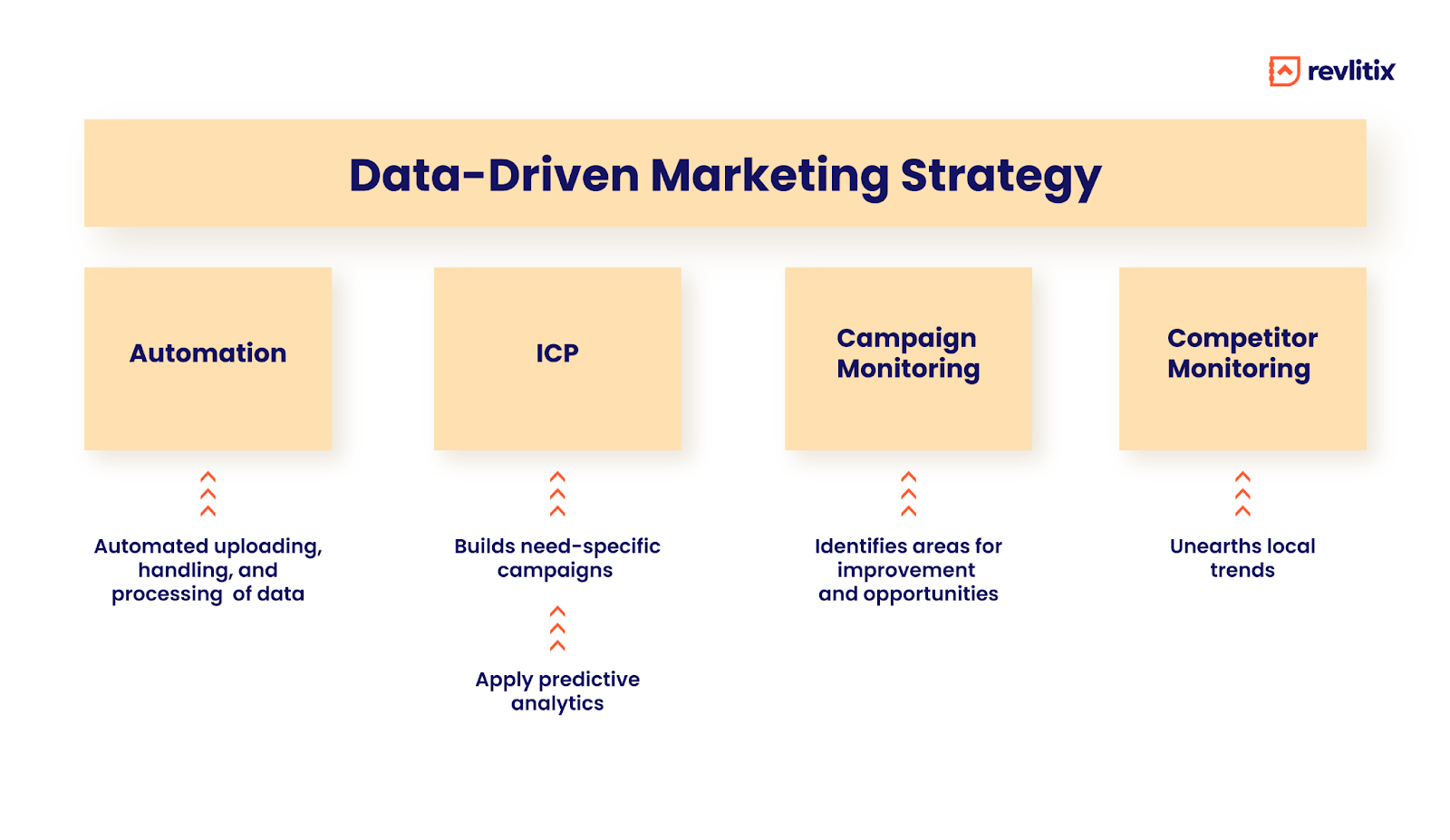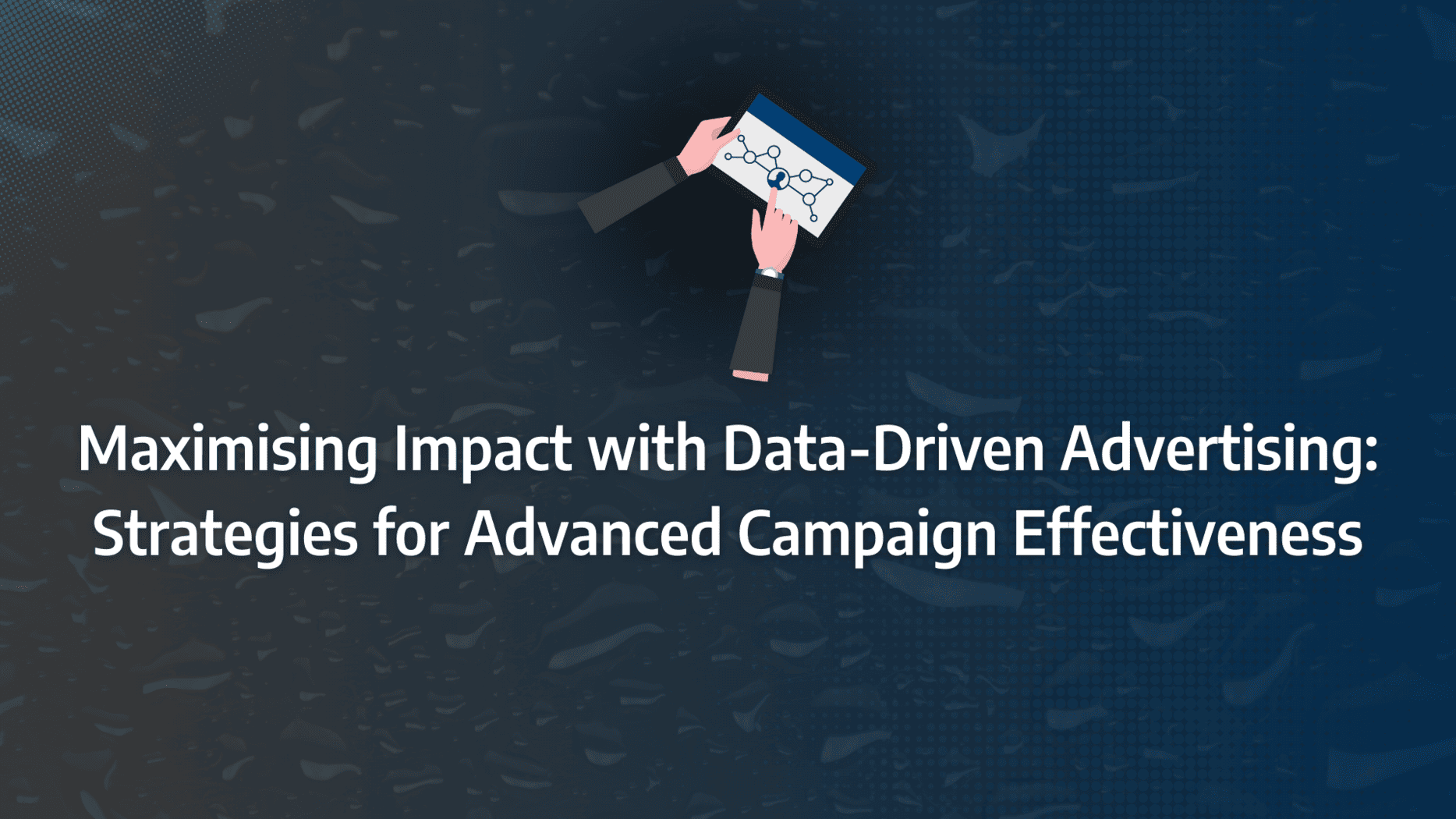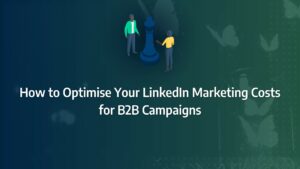Are you tired of throwing your advertising budget into the wind, hoping it will land somewhere profitable? It’s a frustration many marketers share—a campaign that looks promising on paper falls flat when it reaches the audience. The root of this struggle often lies in the absence of one critical element: data. Data-driven advertising isn’t just a luxury; it’s a necessity.
Imagine having the power to precisely target your audience, optimise every ad, and measure success with crystal-clear accuracy. This isn’t just a marketing dream; it’s the reality of data-driven advertising. By the end of this guide, you’ll not only understand the power of data-driven strategies but also gain actionable insights to revolutionise your advertising efforts.
- Data-driven advertising is crucial for creating precise, targeted campaigns that maximise return on investment.
- Utilising first-party and third-party data allows for better audience segmentation and personalised ad content.
- Building a successful data-driven campaign involves systematic data collection, analysis, and continuous optimisation.
- Advanced techniques like A/B testing and predictive analytics can significantly enhance ad performance.
- Key metrics such as CTR, conversion rates, and customer lifetime value are essential for measuring campaign success.
- Challenges such as data privacy and quality issues can be mitigated with the right strategies and skilled personnel.
What are the key advantages of data-driven advertising over traditional methods?
In today’s digital age, traditional advertising methods, often dubbed “spray and pray,” are seeing a decline in effectiveness. This is where data-driven advertising steps in, advancing beyond the outdated “ready, aim, fire” approach by enhancing targeting, personalisation, placement, and timing. Data-driven advertising optimises every facet of a campaign to ensure maximum engagement and conversion.
Data-driven is not just a buzzword but a paradigm shift in business operations. It represents a state where decision-making is powered by data, ensuring actions and strategies are executed efficiently and in real time. The transformation from traditional to data-driven business is akin to the leap from horse-drawn carriages to automobiles, providing speed and efficiency in reaching business objectives. This method integrates high-quality data and algorithmic automation, including artificial intelligence (AI), to streamline and enhance processes.
The Role of Data in Advertising
In the competitive realm of marketing and advertising, standing out and resonating with your audience is paramount. Data-driven advertising enables marketers to craft messages that are not only received but are compelling enough to convert viewers into customers. Access to detailed consumer data allows marketers to understand who their customers are, what they prefer, and their buying habits, painting a comprehensive picture of current behaviours and predicting future trends for more effective campaign strategies.
5 Advantages of Data-Driven Advertising
- Enhanced Customer Experience: Utilising detailed consumer profiles enables marketers to tailor experiences, fostering trust and loyalty between the brand and the consumer. This personalisation leads to improved customer satisfaction and higher returns on investment.
- Optimised Marketing Attribution: Data-driven marketing employs analytics tools to pinpoint the most impactful aspects of your advertising spend, helping to direct budget allocations more effectively by tracking customer movements through the sales funnel.
- Creation of Relevant Content: Insights into consumer preferences guide the creation of content that meets the audience’s expectations at the right time, enhancing engagement and understanding of the market needs.
- Effective Channel Identification: Data informs marketers of the most effective channels for reaching their audience, ensuring that messages are positioned where they will have the greatest impact.
- Data-Informed Decision Making: Making decisions based on solid data insights is invariably more effective than relying on intuition. Data-driven advertising decisions ensure marketing strategies are grounded in reality and tailored to produce the best outcomes.
Traditionally, these elements form the core of a marketing plan. However, integrating these plans with data-driven insights and strategic marketing tools enables businesses to achieve superior outcomes by understanding their current landscape and strategically navigating towards their goals.nbsp;
What Matters Most?
Mapping the customer journey offers invaluable insights that enable businesses to tailor their advertising strategies effectively. Clients often discover that being transparent about data usage not only fosters trust but also significantly boosts engagement, leading to enhanced campaign performance. Furthermore, utilising predictive analytics reveals behavioural patterns that allow organisations to anticipate customer needs, ultimately improving targeting and outcomes.Get In Touch
Formulating Your Data-Driven Advertising Marketing Plan
To begin with the basics, a well-structured marketing plan is your blueprint for action. It encompasses your overarching strategy and the specific tactics required to achieve your business goals. Here’s a breakdown of what should be included:
- Business Objectives & Executive Summary: This section outlines the core aims of your business, whether it’s driving revenue growth or enhancing customer retention. Setting these objectives provides a clear focus for all subsequent marketing efforts.
- Target Audience & Market: Identify who your marketing efforts will address. This involves detailing the demographics of your target market, including age, gender, and interests, to ensure that your messaging resonates directly with them.
- Marketing Strategy: Outline the strategic initiatives your team will employ to drive towards your business goals. This is the backbone of your plan, where you define the approach to reach and engage your target audience effectively.
- Marketing Tactics: Detail the specific campaigns and milestones essential for realising the strategy’s objectives. This section is about the ‘how’ – the practical steps you’ll take to turn strategic vision into reality.
- Marketing Channels: Describe where and how you’ll place your media. This includes choosing the right channels that align with where your target audience is most active, ensuring optimal visibility for your campaigns.
Source: Invesp
Traditionally, these elements form the core of a marketing plan. However, integrating these plans with data-driven insights and strategic marketing tools enables businesses to achieve superior outcomes by understanding their current landscape and strategically navigating towards their goals.

Setting SMART Goals and Implementing KPIs
Rather than letting strategy shape your goals, let your goals define your strategy. This inversion of thinking ensures that your marketing efforts are sharply focused and driven by metrics from the outset. Implementing SMART goals—specific, measurable, attainable, relevant, and time-bound—helps crystallise what you aim to achieve in clearly defined terms.
For instance, if your objective is to boost your organisation’s social media presence by 10% by the end of the second quarter, start by assessing your current follower count across platforms. This data becomes the baseline from which to develop precise Key Performance Indicators (KPIs). You might set a KPI to increase Instagram followers by 20% and Facebook followers by 5%. These KPIs enable you to track and measure the effectiveness of your data-driven advertising and marketing strategies in a detailed, quantifiable way.
By adopting a data-driven approach to your marketing plan, you empower your team to make informed, strategic decisions that are backed by data and geared towards significant, measurable outcomes. Engage with data-driven ads and data-based advertising strategies to not only meet but exceed your strategic goals, ensuring your marketing efforts are as effective and efficient as possible.
Identify and Segment Your Target Market As your organisation crystallises its objectives, it becomes imperative to understand how to harness the needs of your target audience to achieve these goals. Employing data to delineate well-defined, precise target markets and their corresponding customer segments is essential. This strategic approach allows your marketing team to focus on engaging the right customers rather than merely the largest number of customers.
To execute this, analyse the purchasing patterns within your organisation to discern common characteristics among your customers. While niche products might appeal to a relatively homogenous group, most organisations find that their larger target market comprises several distinct segments. Utilising customer data through methods such as clustering analysis is key to identifying groups of customers with similar motivations and needs.
Consider, for instance, a bookstore attracting a diverse clientele, posing the challenge of tailoring communications effectively. Rather than attempting to cater to all with a broad strategy, detailed analysis of sales and customer data can reveal which customer groups are most valuable. Suppose the analysis uncovers two primary segments. The first consists of recent college graduates, aged 22 to 30, who are primarily driven by entertainment and, secondarily, self-education. The second significant segment includes women aged 25 to 35, who predominantly purchase children’s books, prioritising education for others.
Understanding the Buyer’s Journey and Industry Sales Cycles Gaining a deep understanding of your customers is crucial to navigating their buying process effectively. By meticulously analysing the buyer’s journey and the specific sales cycles of your industry, you can pinpoint exactly where a customer stands in their path to purchase. This understanding is pivotal because it directly influences their buying intentions.

The Buyer’s Journey Explained
The buyer’s journey is a structured framework that categorises a customer’s purchasing process into three essential stages: awareness, consideration, and decision.
- Awareness: At this initial stage, customers become aware of a need or problem. Here, marketers should capitalise on the insights gained from segmentation analysis to highlight unmet needs and introduce solutions. The goal is to inform and educate the customer about how their needs can be effectively met.
- Consideration: As customers move into the consideration phase, they start evaluating different solutions offered in the market. This is where your brand should present compelling content and promotional materials that clearly articulate how your offerings are superior to competitors’.
- Decision: The final stage is where the purchase happens. Customers are ready to buy and are seeking the best option available. At this juncture, focus on reinforcing the value of your product and enhancing customer retention strategies to foster long-term relationships.
Understanding where your customer lies within these stages, coupled with a robust analysis of behavioural data from defined customer segments, allows for the targeting of marketing efforts that are highly likely to convert.
Source: McKinsey
Industry Sales Cycles
Incorporating knowledge of industry-specific sales cycles into your strategy is equally important. Sales cycles help determine the optimal times for engaging potential customers based on historical buying patterns. For instance, car dealerships recognise that sales dip during the winter months. They utilise this period to focus on creating brand-centric, seasonal advertising aimed not at immediate sales but at nurturing future buying intentions for the more favourable spring season.
Aligning Customer Experience with Strategic Priorities
Enhancing customer experience is about more than just direct interactions—it involves a holistic strategy that aligns all organisational activities towards delivering superior customer engagements. This process begins by fully understanding the defined customer segments and personas, continuously updating these profiles with new data to keep them relevant and actionable.
Effective customer experience management involves:
- Strategic Alignment: Ensuring all departments, from sales to customer service, are fully integrated and aligned with the overarching customer engagement strategy.
- Continuous Monitoring: Regularly reviewing customer interactions and feedback to adjust strategies and operations accordingly.
- Budget Justification: Securing the necessary budget by clearly demonstrating how enhanced customer experience drives tangible business outcomes.
Ultimately, the aim is to tailor every aspect of the organisation’s operations to not only meet but exceed customer expectations, thereby securing their loyalty and fostering long-term growth. This strategic focus on customer experience is what sets market leaders apart in today’s highly competitive business environment.
Exemplary Instances of Data-Driven Marketing
Data-Driven Marketing Strategy #1: Enhanced Contextual Targeting Using Demographic Data
Imagine you’re keen to promote a new product to your largest customer segment. You’ve already gathered some in-house data on user behaviour, yet you’re missing insights into aspects like weather conditions or comprehensive spending patterns. Utilising publicly accessible datasets can fill these gaps. Consider GreenPal’s approach, which likened itself to “Uber for Lawn Care.”
GreenPal conducted an AdWords campaign targeting the Nashville metropolitan area with promising initial results: a click-through rate exceeding one percent and a conversion rate surpassing 10 percent on its Nashville-specific landing page. Yet, to refine their approach, they delved into census data to glean insights into average incomes and home values across Nashville neighbourhoods. Identifying East Nashville as a community with a more price-sensitive demographic led them to tailor their campaign specifically for this area, using the engaging tagline: “The Cheapest Lawn Mowing in Nashville. Lawn mowing from £20.” This focused approach significantly boosted their metrics, with a 200 percent increase in click-through rates and a 30 percent rise in page conversions, demonstrating the power of data-driven enhancements in advertising precision.
Data-Driven Marketing Strategy #2: Cross-Channel Insights to Bolster Campaign Foundations
Venturing into new marketing territories can be daunting, especially without a solid foundation from existing channels. Hiresquare, a gig marketplace, exemplifies how leveraging data across different marketing platforms can mitigate such risks. Rick Vugts, the founder, explains how they harness pay-per-click (PPC) data to not only optimise their web copy for SEO but to also gain a real-time understanding of search volumes and keyword efficacy.
By analysing short-term PPC campaign results, Hiresquare can identify which keywords hold genuine commercial intent and adjust their strategies accordingly. This method ensures that every new campaign is built on a bedrock of reliable data, significantly enhancing the likelihood of success and providing a strategic edge in competitive marketplaces.
These strategies underscore the transformative impact of data-driven advertising, illustrating how businesses can use precise, targeted approaches to not only meet but exceed their marketing objectives, harnessing the power of data to secure a competitive advantage in the digital age.
Best Practices for Effective Data-Driven Advertising
To maximise the impact of your data-driven marketing efforts, it’s crucial to adhere to established best practices that leverage customer data effectively.
Understanding Your Audience
The cornerstone of successful data-driven marketing is a deep understanding of your audience. Accurate customer data is indispensable. Despite having a robust data collection system, the information gathered is ineffectual if it doesn’t accurately reflect your target audience.
Start by conducting thorough research on your prospective customers. Develop detailed buyer personas and ensure your team is well-versed in these profiles. Engaging directly with your current customers through focus groups allows you to gather genuine insights and feedback, further refining your understanding of your market’s needs.
With a profound knowledge of your customers, the integrity and reliability of your customer data are ensured, empowering your marketing strategies.
Efficient Data Management
Data-driven marketing is dynamic, constantly evolving as new data comes in. Effective data management is pivotal to understand your audience continually, evaluate new marketing opportunities, and optimise your resource allocation. We will explore several data management tools that can aid in these efforts, ensuring your marketing strategies remain agile and informed.
Adherence to Compliance
Respecting privacy laws and remaining compliant are non-negotiable in the realm of data-driven marketing. Regulations such as the General Data Protection Regulation (GDPR) and the California Consumer Privacy Act (CCPA) are designed to protect consumer data and ensure that businesses handle it responsibly. Understanding and complying with these laws not only safeguards your operations but also enhances the trustworthiness and transparency of your marketing efforts.
More Innovative Data-Driven Advertising Techniques
- Retargeting: Retargeting leverages data captured from users’ online activities to present them with relevant advertisements on different platforms. This strategy should be tactful; for instance, rather than aggressively pushing a product, use retargeting to encourage users to engage further with your brand, such as signing up for a free demo. This approach aligns with the user’s current engagement level and enhances the customer experience without being intrusive.
- Predictive Advertising: This technique uses artificial intelligence and statistical algorithms to forecast customer behaviour and responses, enabling marketers to reach potential customers with targeted messages at optimal times. Predictive advertising refines your marketing efforts by anticipating the needs and future actions of users, thus increasing the relevance and effectiveness of your campaigns.
- Data-Driven Search Engine Marketing: With billions of searches conducted daily, search engines offer a vast pool of data that, when intelligently analysed, can drastically improve your search engine marketing (SEM) strategies. Tools like Google Trends and Google Keyword Planner allow marketers to decipher search patterns and trends. This intelligence helps in crafting strategies that not only capture peak search periods but also optimise spending on keywords, making your SEM both strategic and cost-effective.
By integrating these sophisticated tools and practices into your marketing repertoire, you are well-equipped to conduct powerful, data-driven campaigns that not only reach but resonate with your target audience, driving meaningful engagement and conversions.
Our Tactical Recommendations
In our experience, fostering a culture of continuous experimentation is essential for data-driven advertising success, allowing companies to refine strategies based on real-world outcomes. Clients often find that A/B testing ad creatives can lead to significant performance improvements, as even small adjustments resonate differently with audiences. Additionally, leveraging user-generated content typically enhances credibility, making ads more relatable and effective at driving conversions.Get In Touch
What essential tools should I utilise for data-driven marketing success?
Embarking on your data-driven marketing journey requires the right tools to track, manage, and effectively utilise your customer data. Here are some indispensable tools that can elevate your marketing efforts:
HubSpot Marketing Hub
-
- Price: Available in free and paid versions
- Description: HubSpot Marketing Hub offers an all-encompassing solution for businesses eager to adopt data-driven marketing. Integrated directly with HubSpot CRM, it enables you to seamlessly track, analyse, and apply customer data across your marketing efforts. This platform allows for the creation of optimised content, the launch of segmented email campaigns, active monitoring of social media engagements, and the execution of sophisticated retargeting ad campaigns. Whether you’re a small startup or a large enterprise, HubSpot Marketing Hub provides the tools to craft a personalised, data-enriched marketing strategy.
Google Analytics
-
- Price: Free
- Description: Google Analytics is the cornerstone tool for digital marketers focused on data-driven strategies. It offers robust tracking and reporting capabilities that help you understand crucial aspects of your website’s user behaviour, including traffic sources, bounce rates, visitor sessions, and customer demographics. Integrating seamlessly with Google Ads, it allows for comprehensive reporting on your advertising performance, enabling you to adjust your strategies based on real-time data insights. With Google Analytics, you gain a deeper understanding of your acquisition channels and conversion metrics, making it easier to optimise your marketing efforts.
Buzzsumo
-
- Price: Paid
- Description: Buzzsumo is a powerful tool for content marketers who rely on data to drive their content strategies. It assists you in optimising your web content by providing insights into the most effective keywords, content types, and industry trends. With Buzzsumo, you can also monitor your digital brand performance and conduct competitive analysis to see how your content stacks up against others in your field. Utilising customer data, Buzzsumo helps you to identify and capitalise on content trends, ensuring your marketing communications resonate with your target audience and achieve significant engagement.
These tools are integral to implementing a successful data-driven marketing strategy. They provide the technological foundation necessary to analyse vast amounts of data, gain actionable insights, and tailor your marketing initiatives to meet the specific needs and preferences of your audience. By leveraging these tools, you can ensure that your marketing efforts are not only informed by data but are also adaptable to the ever-evolving digital landscape.







